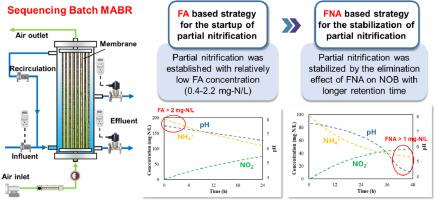Water Research ( IF 12.8 ) Pub Date : 2023-06-02 , DOI: 10.1016/j.watres.2023.120168 Lisheng Wang 1 , Xiaofeng Kang 1 , Yanchen Liu 1 , Xia Huang 2

|
Membrane aerated biofilm reactor (MABR) has attracted a lot of attention as an energy-efficient integrated nitrogen removing technology in recent years. However, it is lacking of understanding to realize stable partial nitrification in MABR because of its unique oxygen transfer mode and biofilm structure. In this study, free ammonia (FA) and free nitrous acid (FNA) based control strategies for partial nitrification with low NH4+-N concentration were proposed in a MABR of sequencing batch mode. The MABR was operated for over 500 days under different influent NH4+-N concentrations. With the influent NH4+-N of around 200 mg-N/L, partial nitrification could be established with relatively low concentration of FA (0.4–2.2 mg-N/L) which suppressed nitrite oxidizing bacteria (NOB) on the biofilm. With lower influent NH4+-N concentration of around 100 mg-N/L, the FA concentration was lower and strengthened suppression strategies based on FNA were needed. With the final pH of operating cycles below 5.0, the FNA produced in the sequencing batch MABR could stabilize partial nitrification by eliminating NOB on the biofilm. Since the activity of ammonia oxidizing bacteria (AOB) was lower without the blow-off of dissolved carbon dioxide in the bubbleless MABR, longer hydraulic retention time was required to reach a low pH for high concentration of FNA to suppress NOB. After exposures to FNA, the relative abundance of Nitrospira was decreased by 94.6%, while the abundance of Nitrosospira increased greatly which became another dominant AOB genus in addition to Nitrosomonas.
中文翻译:

序批式膜曝气生物膜反应器无游离亚硝酸基部分硝化反应
近年来,膜曝气生物膜反应器(MABR)作为一种高效节能的一体化脱氮技术备受关注。然而,由于其独特的氧传递方式和生物膜结构,在MABR中实现稳定的部分硝化作用还缺乏认识。在这项研究中,提出了在顺序批处理模式的 MABR 中基于游离氨 (FA) 和游离亚硝酸 (FNA) 的低 NH 4 + -N 浓度部分硝化控制策略。MABR 在不同的进水 NH 4 + -N 浓度下运行了 500 多天。随着进水NH 4 +-N 约为 200 mg-N/L,部分硝化可以用相对低浓度的 FA(0.4-2.2 mg-N/L)建立,这抑制了生物膜上的亚硝酸盐氧化细菌(NOB)。与较低的进水 NH 4 +-N 浓度在 100 mg-N/L 左右,FA 浓度较低,需要基于 FNA 的强化抑制策略。当操作循环的最终 pH 值低于 5.0 时,在测序批次 MABR 中产生的 FNA 可以通过消除生物膜上的 NOB 来稳定部分硝化作用。由于在无气泡 MABR 中没有排出溶解的二氧化碳,氨氧化细菌 (AOB) 的活性较低,因此需要更长的水力停留时间才能达到高浓度 FNA 的低 pH 值以抑制 NOB。FNA暴露后,Nitrospira的相对丰度下降了94.6%,而Nitrosospira的丰度大大增加,成为除Nitrosomonas之外的另一个优势AOB属。


























 京公网安备 11010802027423号
京公网安备 11010802027423号